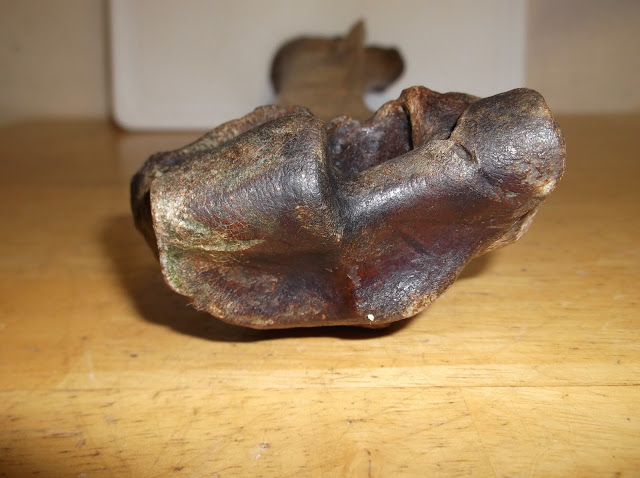Sunday, 29 January 2012
Jurassic fossil slabs and fossil wood from the Stainton gravel beds
Location:Cleveland England
Maltby, Stockton-on-Tees, UK
Thursday, 12 January 2012
Horse Radius
Location:Cleveland England
Coulby Newham, Middlesbrough, UK
Tuesday, 10 January 2012
Maltby clay Deposits
 Ive now cleared the gravel bed, and have noticed it is interrupted by a stoneless deposit, it can be seen to the right of the spade handle.
Ive now cleared the gravel bed, and have noticed it is interrupted by a stoneless deposit, it can be seen to the right of the spade handle. There is the same intrusion by the same type of deposit in the gravel bed a km east at Stainton beck.
There is the same intrusion by the same type of deposit in the gravel bed a km east at Stainton beck. This is a close up of the deposit that intrudes the gravel bed, there is another separate blue layer above then the dry hard packed friable red brown loamy clay that lays above everything in this area.
This is a close up of the deposit that intrudes the gravel bed, there is another separate blue layer above then the dry hard packed friable red brown loamy clay that lays above everything in this area. Close up of the gravel bed with the dark red clay below, i now am sure this gravel bed is part of what i have now named the Stainton gravel beds.
Close up of the gravel bed with the dark red clay below, i now am sure this gravel bed is part of what i have now named the Stainton gravel beds. The lower thin clay layers look like there painted with gloss, the image really doesn't do them justice.
The lower thin clay layers look like there painted with gloss, the image really doesn't do them justice.More can be viewed regarding the Stainton gravel beds by clicking the link below
The Stainton gravel beds
The link below shows the locations of known Stainton gravel bed deposits.
http://goo.gl/maps/fBft6
Location:Cleveland England
Stainton and Thornton, Middlesbrough, UK
Sunday, 8 January 2012
Maltby beck deposits
After scraping away the stuff shrouding the deposits, i could make out that i had the same sequence of deposits as at Stainton beck about a km to the east.
 There seems to be at least 7 different layers in this excavation and as at Stainton the gravel bed is rich in fossils.
There seems to be at least 7 different layers in this excavation and as at Stainton the gravel bed is rich in fossils.
 This red-orange deposit was a surprise Ive not come across it before, at least not in this state.
This red-orange deposit was a surprise Ive not come across it before, at least not in this state.
 This pic shows the sequence of deposits including a thin layer of blue clay below the red orange deposit.
This pic shows the sequence of deposits including a thin layer of blue clay below the red orange deposit.
Location:Cleveland England
Stainton and Thornton, Middlesbrough, UK
Tuesday, 3 January 2012
Blue clay found above the Stainton gravel beds.
To the right half of the image above ive cleared the brown red clay from above the blue deposit.
(25,01,12) I now know the blue- grey deposit is thicker than first thought, ive recently found it to be over a metre thick 3 metres up stream.
More can be viewed regarding the Stainton gravel beds by clicking the link below
The Stainton gravel beds
Location:Cleveland England
Stainton and Thornton, Middlesbrough, UK
Saturday, 31 December 2011
Blue deposits
Some of the red you can see is caused by the dust from the deposits above but there are a lot more of the red veins than first thought.
 The clay both red and blue is extremely tough almost rock like, and appears greasy.
The clay both red and blue is extremely tough almost rock like, and appears greasy.
 The clay both red and blue is extremely tough almost rock like, and appears greasy.
The clay both red and blue is extremely tough almost rock like, and appears greasy.The image below i think shows two separate red brown layers, something we did not notice with the cores taken with the auger.

 I have dug a 1.5 metre test hole about 15 metres down stream, with no sign of the blue deposit, so it seems this is a high point in the blue deposit at least as far as the beck side is concerned.
I have dug a 1.5 metre test hole about 15 metres down stream, with no sign of the blue deposit, so it seems this is a high point in the blue deposit at least as far as the beck side is concerned.More magnetic rock found in the Stainton gravel beds.
Unknown rock dug from the Stainton gravel beds, the magnets used are not rare earth magnets.
Location:Cleveland England
Stainton and Thornton, Middlesbrough, UK
Subscribe to:
Comments (Atom)
















































